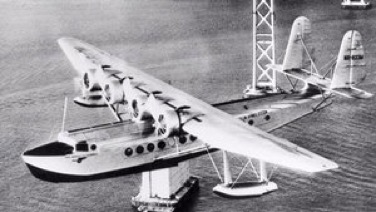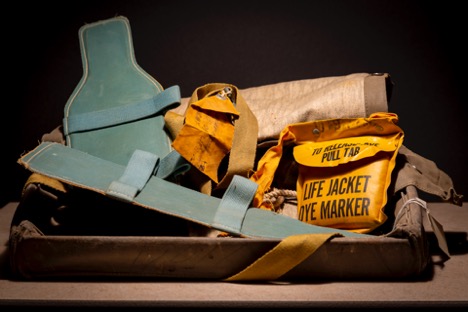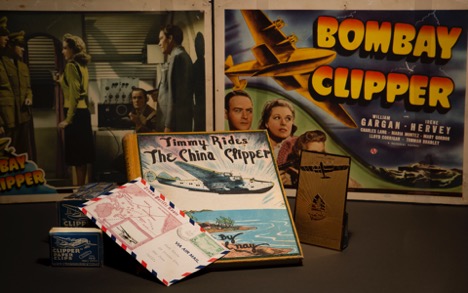Produced between 1938-41, the Boeing 314 flying boat, also known as a “clipper,” achieved more than any other aircraft of its time. Named after mid-19th century sailing ships, these aircrafts flew from the United States to the United Kingdom and made stops in Ireland, the Philippines, Guam, Australia, and New Zealand. The clippers were designed just before the outbreak of World War II, when very few cities had runways capable of accommodating such large aircrafts. Anticipating this obstacle, Boeing produced a long-range plane that could land anywhere, including water. Though twelve clippers were produced at the Boeing factory in Seattle, Washington, Pan American World Airways only flew nine of the aircrafts.

Photo credit: Smithsonian National Air and Space Museum Photo caption: Moments after taking off on the first survey flight to Hawaii on April 16, 1935, the Pan Am clipper passes the San Francisco-Oakland Bay Bridge.
So what was it like to be inside one of these luxury Pan Am clippers? In 1936, journalist H.R. Ekins took a flight from San Francisco to Hawaii to find out. The trip took eighteen-and-a-half hours. Ekins describes the interior of the vehicle as being unapparelled in class and sophistication. “Her [the clipper’s] interior was like that of no other airplane. Her lounge would seat sixteen passengers comfortably, leaving plenty of space to walk about.” The seaplane was “as roomy as the [airship] Hindenburg and as steady as a rock.”1 Another passenger, Charles McKew Parr, describes the food: “It was a conventional supper–grapefruit, celery and olives, soup, steak, vegetables, salad, ice cream, cake and coffee. The captain acted as though we were his guests.”2 Not only were the clippers used to transport and entertain the elite, they also served the purpose of shepherding mail across the Atlantic.

A piece of mail carried by Pan Am clipper. Found in The Historic Trust’s collection
Seating on the clippers could accommodate more than one-hundred-and-fifty passengers. Built for extravagance, seats on the Pan Am clippers could convert into beds for comfortable overnight accommodations. Almost exclusively marketed to the wealthy, a flight from New York to Southampton, England, in the early 1940s, cost upwards of $675 dollars. Factoring in inflation, that is equivalent to roughly $12,000 dollars1 today. Those who could afford the cost of travelling via Pan Am clipper, could look forward to a 14-seat dining room, crystal glassware and full waiter service. Each passenger had a bed to sleep in. Those looking for an even more luxurious experience could book their own private sleeping and dining compartment. Some clippers even included a bridal suite.
Most people who elected to travel via clipper prioritized the luxurious or unique experience over efficient travel. They enjoyed the ride. Compared to modern air travel, the Pan Am Clippers were quite slow, with a cruising speed of 188 miles per hour3. The modern Boeing 777, by contrast, flies at a speed of 560 miles per hour.
One of the most impressive accomplishments of the Boeing clippers occurred when a Clipper, taking off from Honolulu, was forced to circumnavigate the globe in order to safely travel during the attack on Pearl Harbor. Rather than land in Hawaii as planned, the clipper flew west to New Zealand, and then onto New York, travelling a total 0f 31,000 miles to land in LaGuardia4. Though unintentional, this Pacific clipper became the first commercial aircraft to make a trip around the world, proving once again that necessity is the mother of invention.

Safety was a top priority for clipper voyages. A Life Jacket and other safety supplies found in The Historic Trust’s collections. Photo credit: Bob Holcomb
The final clipper flight took place in 1941, before the outbreak of war in the Pacific made commercial transoceanic flights too dangerous to pursue. By the end of World War II, the need to land aircrafts on water became superfluous as planes could land on runways built on ships. The last Pan American clipper was retired in 1946, after flying more than a million miles.

Clipper memorabilia found in collection Photo credit: Bob Holcomb
Interested in learning more about what it was like to travel in a Boeing clipper? Click here to watch a film from 1958: https://www.youtube.com/watch?v=OdMumlGLxJo
[1] simpleflying.com [2] airandspace.si.edu [3] pearlharboraviationmuseum.org [4] medium.com
